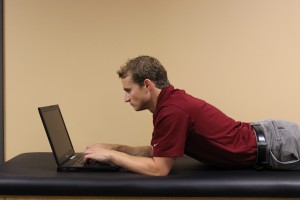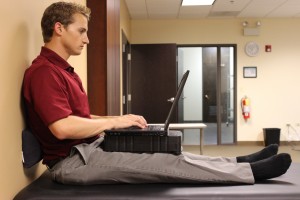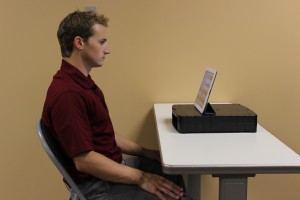
Ergonomics for the Students’ World
Leave a CommentIn 2008, 49.3 million students were enrolled in schools from grades one through twelve. These students are potentially sitting incorrectly at their school desks, computer workstations, or at home for more than eight hours each day. Due to the fact that repetitive strain injuries such as carpal tunnel syndrome, medial & lateral epicondylitis, & herniated discs are related to cumulative trauma, it’s imperative that we teach & adhere to sound ergonomic principles from a young age. The following guidelines can help mitigate stress on the body & contribute to a pain-free, healthy body:
Student Desks:
- Feet should rest flat on the floor or on an ergonomic footrest & proper spacing should exist between the knees & the seat pan (approximately 2”). Doing so ensures proper circulation to the lower legs & feet. Shoes may feel tight, or tingling & numbness may be experienced when circulation is decreased to the feet.
- Always sit as far back as possible utilizing the entirety of the chair’s backrest. Forward leaning increases the amount of force on the lumbar vertebrae & can lead to pain in the lower back.
- Upward reaching, particularly while writing or keyboarding, should be eliminated whenever possible. Upward reaching is fatiguing for the shoulders & can cause excessive rubbing of the shoulder muscles leading to an increased possibility of rotator cuff strain. If your chair is not adjustable, consider using a thick seat-cushion to increase your seated height.
- Five-minute rest breaks between classes or lessons are a great opportunity to stand-up & incorporate dynamic movement into the school day. During these breaks, take a trip to the restroom, fill up your water bottle, & remove yourself from the seated position. Doing so will remove excess inflammation from joints & refocus your attention for the next class or learning exercise.
Computer Workstations: Although all of the suggestions above relate to computer workstations, visual displays provide another risk factor to watch out for.
- While using computer workstations it’s important to allow our ocular muscles to relax as much as possible. Monitors are in the “intermediate viewing zone” which is particularly fatiguing for the eyes. Be certain to look 20 feet away from your workstation for 20 seconds every 20 minutes. Computer-vision syndrome can be avoided by adhering to this simple guideline.
Studying at Home: When I was in high school, I spent many nights with my textbooks & laptop in my bed lying in a prone position with my neck extended back. I quickly experienced the aches & discomfort associated with this position & decided to sit upright with my laptop in my lap. Again, I began experiencing discomfort related to my forward flexed neck-position.
If you’re using a laptop on the couch or in your bed, consider using a cushioned laptop stand. These products provide separation from the heat of the laptop & your legs while lifting the laptop to decrease neck flexion. Some laptop stands will include a cooling-fan to reduce the likelihood of your computer from overheating. Additionally, maintain normal spinal curvature by using a foam pillow and sitting as far back in the seat pan as possible.
If you’re using a tablet, use a case or a tablet stand that will angle the tablet upwards to reduce neck flexion. Textbooks or hard-copy documents should also be angled upwards to reduce neck & shoulder fatigue.
Incorporating appropriate ergonomic principles can be the difference between excessive after-school soreness & going to athletic practices or other extracurricular activities ready to perform!
If you’re experiencing soreness or pain, request an appointment at an Athletico Physical Therapy clinic near you.
Click to Request an Appointment Today
The Athletico blog is an educational resource written by Athletico employees. Athletico bloggers are licensed professionals who abide by the code of ethics outlined by their respective professional associations. The content published in blog posts represents the opinion of the individual author based on their expertise and experience. The content provided in this blog is for informational purposes only, does not constitute medical advice and should not be relied on for making personal health decisions.



